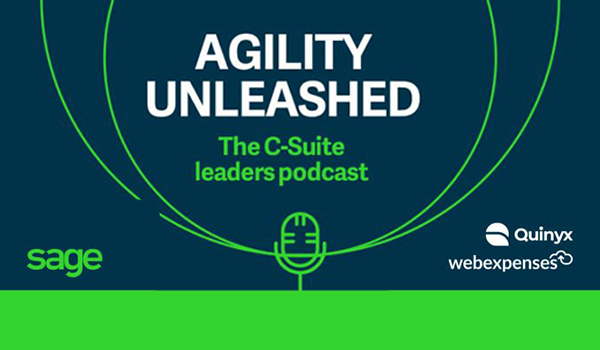
‘Agility Unleashed’ Podcast: ‘The Role of The COO’
“Agility Unleashed” is a Sage podcast series, helping Britain's businesses navigate their way out of the pandemic.
Sit in on this roundtable discussion on business agility. Over the past year, the pandemic has required individuals and businesses alike to be flexible and adapt. This agility made the role of COO come into the spotlight: managing remote working, production lines, and even entirely new business models. But what exactly does a COO do? And how can we learn from them?
Charlie Dabney, (Head of Operations at Global Mobility Executive), Daniel Holmberg, (Head of Sales at Quinyx), Adam Reynolds, (CEO at Webexpenses), and Molly O'Riordan (Vice President of Business Operations at Sage) sit down to discuss - and look at how businesses can use these strategies moving forward.
So what can we learn from these new masters of agility? Here are our four key takeaways from ‘Agility Unleashed'.
1. It’s all about agility
The pandemic has been a major test of company agility. The businesses that handled it best were those who could manage the rapid changes that were required. For Dabney, it has been about being fluid; adapting their company events, and working to change things up virtually.
"Some clients didn't want to switch at all to virtual, but by the end of 2020, they were starting to switch to virtual because there was realization there that it wasn't changing. We've just had to be more flexible and they've been more flexible. So it's fluid constantly.”
It marks a shift, perhaps permanently, from the rigidity of a traditional annual business strategy. And is replaced with a more reactive and real-time approach, thanks to technology and our adaptation into remote work and professional flexibility.
2. ‘Wake up' call for digital
The past 12 months have served as a ‘wake up’ for businesses stuck in traditional, non-digital processes. O'Riordan states: “Once you were forced to go home if you didn’t have that agile cloud-based technology, you were in trouble”.
Automation, AI, and digital data are no longer options. They’re necessities.
Reynolds pointed out - and the others agreed - that for years, many companies have under-delivered on technology. Often, our home technology far exceeds work technology. Recent graduates joining the workforce expect tech-forward business practices and instant access.
For Quinyx’s Holmberg, “There's a huge promise there that technology can bring and bridge that gap between, making that a real promise for both employees and employers.”
And for Webexpenses, the significant rise in demand for digital invoice processing was evidence. While employees work from home - and without printers - businesses turned to digital ways to solve old, manual, paper-based problems.
Ultimately, the importance of tech is about improving work efficacies - and the need to be flexible catapulted many businesses into the latest technologies.
3. The life of the COO
The group discusses their predictions for the life of the COO over the next year and here’s what they each said.
Reynolds stated that “There's been a real focus on what is one of the most difficult roles in the organization.” You could even say it's been undervalued until now and “Everything at its lowest level is operational – it's the kind of things that keep us moving. So I think it's a really tough role to manage and it's one that requires a really strong team as well.”
For Dabney and the world of networking events, “People are keen to get back face-to-face, especially from a sales perspective, you can't beat networking face-to-face with people. It's where people want to be.”< Holberg agreed, “I'm hoping that my team will be able to go out and meet customers in a way we might not have done in a long time. So I'm making a prediction that there will be a craving for face-to-face interactions.”
4. Work harder, not smarter
Wrapping up, the group paused with Reynolds new approach to work including for the COO, “stop saying ‘yes’ and start asking ‘why’.” A move away from a traditional approach to work performance. Instead of looking at what employees are doing, the focus should be on ‘why’ they are doing them.
The group all agreed with the move to remote working, ‘looking busy’ should be replaced by a much more goal-orientated approach. And, ultimately, what’s achieved is more important than how it’s done.

